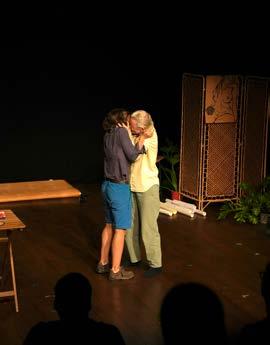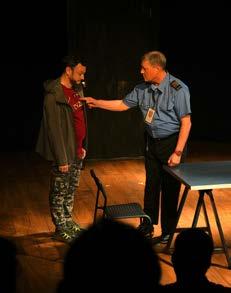
9 minute read
The Sword, the Golf Club, and the Walkingstick: Elsewhere Theatre’s Dangerous Art
Elsewhere Theater's Dangerous Art
TEXT: ALTON BEAUNE
My girlfriend and I recently saw a set of three modern plays. The program, Dangerous Art, was presented by Taipei’s Elsewhere Theater Company(ETC) in partnership with the Red Room. Barry Hall, dramaturge, conceived and directed the three plays as a set, with an eye for correspondence.
The Guling Street Avant-Garde Theatre ( 牯嶺街小 劇場) provided the venue. The theatre, a black box in downtown Taipei, puts a historic building to new use. As far as my friend and I know, Dangerous Art marks the debut of English-language theatre in the venue. The seating adapts itself to any number of configurations. Lighting equipment gives the production team an array of options, and the acoustics work well for spoken theatre. Partitioned for Dangerous Art, the staging area was deep, with Chinese-language surtitles projected on the upstage curtain. The lobby is a welcoming place for photos, and mingling.
Resident English-language performance art in Taiwan finds many forms. They include storytelling and poetry readings, sketch comedy, stand-up and open mikes, competitions, improvisations, musical and folkloric and educational events. Where does ETC fit?
The company is professional at every layer. As the name implies, the Elsewhere’s repertory emphasises imports from abroad. Viewers can expect thoughtfully chosen works presented by experienced thespians who respect their craft, their material, and their audience.
Dangerous Art offers three well-crafted plays—all knowingly cast, astutely directed, and acted from both head and heart. Each thespian involved has a meaningful moment. Audiences leave with plenty to ponder.

Let’s explore.
Barry Hall: Damnation (2023)
Art, as a condition of its creation, requires solitude— what psychologist Anthony Storr describes as ‘willed introversion.’ The protagonist of Barry Hall’s Damnation goes to considerable lengths to secure hers.
Judith (Sarah Brooks), taking a page from Paul Gaugin, maintains a patch of quietude for herself in a time zone far east of the media centres she once inhabited. Lush paintings and line drawings flourish in her studio hideaway. She keeps to her routines—but, like her biblical namesake, she is ready with a sword any time it seems the barbarians may be at the gate.
The horde arrives in the form of a single herald: Alex (Erin Adele Clark). A worshipful scholar, she has tracked down Judith with the goal of penning a biography. She reminds Judith of her stature in the art world and reveals that two decades of self-imposed exile have only deepened others’ desire to know more about her. Alex wants interviews, Judith craves solitude. The historian, in love with her subject and on fire with inspiration, will not be denied—as Judith, who knows something about both, recognises. Her paradise now breached, Judith takes one last stab at being understood.
Sarah Brooks presents a compelling figure on stage, portraying the turbulence of light and shade in her character as she weighs choices. Erin Adele Clark gives an intense performance as an awed but irrepressible Valkyrie.
Nicholas Thurkettle: The Rothko (2016)
A comedy by California’s Nicholas Thurkettle gives us the play most concerned with art itself. Its dialogues touch on questions about value, aesthetics, mercantile, cultural and personal standards, and the best environments for experiencing art. Is it possible to extend UNESCO-type protections to more recent art, what is the role of the irrational in our responses to art. In the process, we get an informative peek behind the scenes at the inner life of art museums. If all this sounds dry, rest assured it is anything but. More on that in a moment.
Ours is a time in which many who frown at the thought of library censorship nevertheless find it amusing to imagine the destruction of visual art. A running gag that began on social media with a naïve parishioner’s wreck of a church fresco, a street artist’s shredding of his work after auction, and a wag’s proposal to ‘eat the Mona Lisa’ is today being run with increasing verisimilitude. A widely viewed movie now shows its leads burning Leonardo’s Gioconda as a punch line, as the latest arrest of activists in Europe is for defacing a Claude Monet garden in the name of conservation. Will the winds of fashion shift before acting out moves further toward the literal? Let’s hope so. Until then, let’s at least have it said: To destroy books and to destroy visual art is essentially the same act.
I was wary, then, when told I was in for an impish comedy about someone who damages art. Despite this, ‘The Rothko’ won me over. The play acknowledges popular stereotypes about ‘the art world’ and goes beyond them to illuminate a way forward. And the ride is a lot of fun.
A uniformed security guard (Gary Edward Gitchel) introduces us to the play as if we were a tour group entering a gallery.


A museumgoer, played winningly by Charlie Storrar, has kicked a hole in a Mark Rothko painting. Though outrageous, his act springs from a sincere aesthetic response: he finds the colour ugly. He embodies John Ruskin’s ideal of ‘the innocent eye’—and now sits detained by security.
The museum director (Sharon Landon) enters, understandably seething, to impress upon the man the magnitude of his transgression. This proves to be tough. Her concerns range over a variety of priorities that he challenges with questions, while his single-minded focus on the aesthetic and the personal puts coherence on his side. He ends up making a surprisingly persuasive case for kicking art that we don’t like. The imp in all of us laughs. Even if we like Rothko.
An interlude has him asking the security guard about a typical day at the museum. The guard describes the variety of ways he has seen museum visitors interact with the art. Love, he suggests, is the problem: it makes people do irrational things. The guard professes only a detached interest in art himself. He’s just a blue-uniformed Everyman… who sports a pink wristwatch.
The museum curator (Yi-Show Lin) arrives in a state of grief. She is kind to the detainee but informs him without exaggeration that this is the saddest day of her life. In answer to his questions, she describes what art restorers do—the training and painstaking labour put into every work, so that all may have a safe and comfortable place to explore their own responses to art. He begins to see the problem.
Gary Edward Gitchel is a natural, convincing presence as the golf-loving security guard. Sharon Landon is everything you want in a wrathful avenger who has been handed far too many headaches in one day. Yi-Show Lin’s heartfelt performance offers a big valentine to all those who work behind the scenes every day to give us nice things. Charlie Storrar’s sparkling performance is the energy driving the whole. He owns this role down to the sneakers.
Murray Schisgal: The Artist and the Model (1992)
Brooklyn native Murray Schisgal (1926–2020) brought aspects of post-WW2 absurdism (Samuel Beckett, Eugène Ionesco) into the vaudeville world of New York’s immigrant Jewish community. Best known for his Broadway play Luv (1964) and his contributions to the screenplay for Tootsie (1982), Mr Schisgal counted Eli Wallach, Ann Jackson, Alan Arkin and Dustin Hoffman among his lifelong collaborators.
The Artist and the Model presents two characters, one of whom never speaks. Schisgal’s precedents here were ‘The Grand Inquisitor’ (Fyodor Dostoevsky The Brothers Karamozov, 1879) and The Stronger (play by August Strindberg, 1881). As in both earlier works, the silent character is the target of accusation.
A young model (Lizzy Mew) arrives late to an artist’s studio in New York. She hurriedly disrobes and strikes a pose, but the artist (D C Rapier) is fuming. He launches into an extended diatribe that will sound familiar enough to anyone who has ever shared a bus with someone ranting about ‘young people nowadays.’ In the process the artist seems torn between his lifelong pursuit of beauty and the impulse to kick his own Rothko.
The model, meanwhile, says nothing. She’s like an audience, in a way.
But so is he. The artist demands a certain performance for the money paid out. Under the acid rain of barked orders, generational putdowns, and involuntary memories, something of a three-part structure takes form—a sonata in prose with a surprisingly lyrical centre. The theme has something to do with the pursuit of beauty and the possession of it, and the chasm between the two. Perhaps it is telling that Mr Schisgal described his own work as never done, each new play starting out as an attempt to ‘explain the last one.’
Lizzy Mew achieves the seemingly impossible, projecting a proud inner stature even as her character maintains her studied inscrutability. D C Rapier gives a brilliant portrayal of a character lunging through all the turmoil of his first crush, even if it’s the thousandth time he has experienced it.
The time arrives for the model to have her say. What happens invites more than one interpretation, but there’s no mistaking a trace of grace.
Damnation (2023)
Judith Stein Sarah Brooks
Alex Green Erin Adele Clark
The Rothko (2016)
Man Charlie Storrar
Museum Director Sharon Landon
Curator Yi-Show Lin
Security Guard Gary Edward Gitchel
The Artist and the Model (1992)
Artist D C Rapier
Model Lizzy Mew
Elsewhere Theatre’s Dangerous Art
Barry Hall has directed Dangerous Art with attention to the threads of correspondence. Across all three works, motifs recur, and images find repetition and reversal. This is theatre which shows what Thomas Carlyle called ‘an infinite capacity for taking pains.’
And here we are at the end of the review, with so much about art left to explore. We’re unlikely to settle every mystery for ourselves—but isn’t it nice to have theatre that sparks the questions?
Elsewhere, thank you. More, please.
https://www.facebook.com/etcproductions
A T Beaune is a writer, filmmaker, actor, and musician. He has resided in Taiwan since 2004.
IMDb imdb.me/atbeaune
Links linktr.ee/atbeaune











